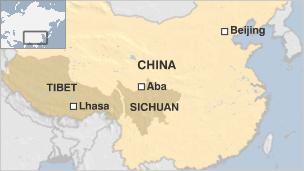The Tibet issue: Tibetan view
- Published

The Dalai Lama's director of information, Thubten Samphel, outlines the Tibetan government-in-exile's stance on the China-Tibet issue.
Is Tibet part of China?
"It is beyond dispute at various periods of its long history that Tibet came under differing degrees of foreign influence: the Mongols, the Gurkhas of Nepal, the Manchu emperors of China and the British rulers of India all played their parts. At other periods in the plateau's history, it was Tibet which exercised power and influence over its neighbours - including China.
It would be hard to find any state in the world today that has not been subjected to foreign domination or influence at some era in its history. In Tibet's case the degree and duration of foreign influence and interference was relatively limited."
What was Tibet like before the Communists established control in 1951?
"Traditional Tibetan society - like most of its Asian contemporaries - was backward and badly in need of reforms. However, it is completely wrong to use the word "feudal" from the perspective of medieval Europe to describe traditional Tibetan society. Tibet before the invasion, in fact, was far more egalitarian than most Asian countries of that time. Hugh Richardson, who spent a total of nine years in Tibet as Britain's last and independent India's first representative, wrote: "Even communist writers have had to admit there was no great difference between rich and poor in [pre-1949] Tibet."
What has happened since then?
"An internal Chinese military document states that from 1952 to 1958, the People's Liberation Army crushed 996 rebellions and killed over 10,000 Tibetans in the north-eastern region of Kanlho. Golog, another Amdo area, saw its population halved from an estimated 140,000 in 1956 to about 70,000 in 1964.
Referring to this area, the late Panchen Lama [the second most important figure in Tibetan Buddhism after the Dalai Lama] told Beijing's leaders: "If there was a film made on all the atrocities perpetrated in Qinghai Province, it would shock the viewers. In Golog area, many people were killed and their dead bodies rolled down the hill into a big ditch. The soldiers told the family members and relatives of the dead people that they should celebrate since the rebels had been wiped out. They were even forced to dance on the dead bodies."
Who was behind a failed uprising against Chinese rule in 1959, after which the Dalai Lama fled to India?
"The '59 uprising against Chinese rule was a people's movement to resist all the changes the Chinese Communist Party were introducing in Tibet.
In the 17 Point Agreement signed between Tibet and China in 1951, the Chinese Communist Party promised that in return for Tibet coming to the fold of motherland, China would not change Tibet's traditional social system or tamper with the powers of the Dalai Lama. Both these promises were not kept, and the introduction of collectivisation and other aspects of the social system in Tibet forced the Tibetans to rise up."
Who was responsible for the 2008 unrest in Tibet?
"In the early 1980s, a liberal policy was introduced in Tibet. This policy dismantled collectivisation and there were plans to withdraw 85% of the Chinese cadres working in the Tibet Autonomous Region. This policy was aimed at letting Tibetans govern themselves.
However, in 1994, all these liberal measures were withdrawn and a new policy called "grasping with both hands" was implemented in Tibet. This policy continued Tibet's economic development while reimposing political repression targeted at undermining Tibetan culture and Tibetan Buddhism. The widespread protests in Tibet are Tibetans' resistance to this hardline policy."
- Published27 January 2012